Distributed deployment of Apollo configuration center under CentOS8
Preface##
As we all know, Apollo is Ctrip's open source configuration center, so the Chinese documents are relatively complete, so I won't go into details here. The main purpose of this article is to record how to deploy Apollo Configuration Center in a distributed manner under CentOS8. Apollo's feature highlights:
- Unified management of the configuration of different environments and different clusters
- Configuration changes take effect in real time (hot release)
- Version release management
- Grayscale release
- Authority management, release review, operation audit
- Client configuration information monitoring
- Provide Java and .Net native clients
- Provide open platform API
- Relatively simple to deploy
- Complete Chinese documentation
The official distributed deployment document:
- [ Distributed Deployment Guide](https://github.com/ctripcorp/apollo/wiki/%E5%88%86%E5%B8%83%E5%BC%8F%E9%83%A8%E7%BD%B2 %E6%8C%87%E5%8D%97)
If you just want to quickly build an Apollo environment during local development, refer to the official Quick Start:
Ready to work##
The following figure is an overview of the Apollo architecture modules:
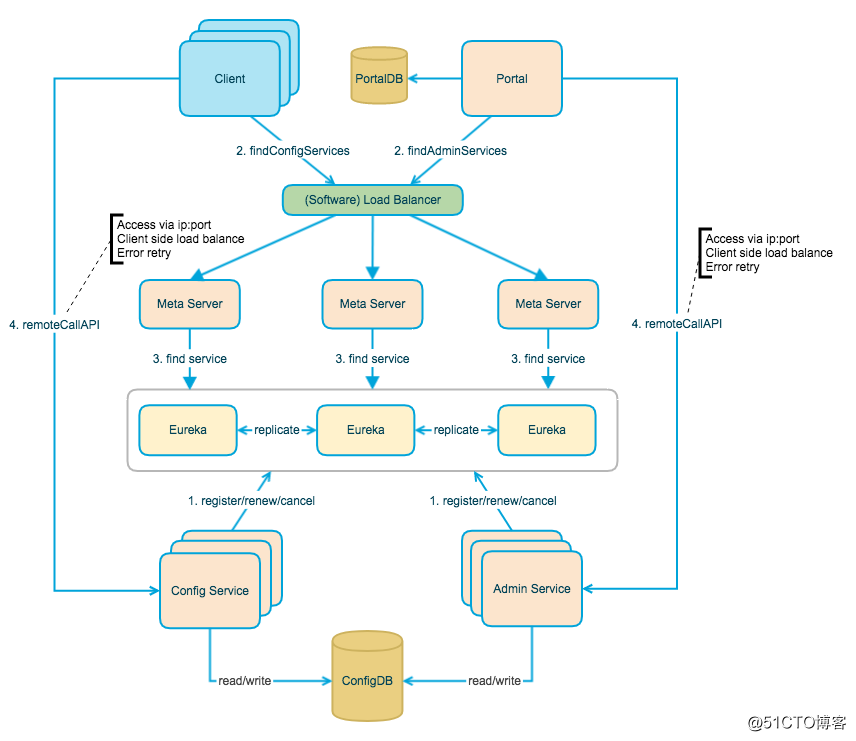
The above figure briefly describes the overall design of Apollo, we can see from the bottom up:
- Config Service provides functions such as configuration reading and pushing, and the service object is the Apollo client
- Admin Service provides functions such as configuration modification and publishing, and the service object is Apollo Portal (management interface)
- Both Config Service and Admin Service are multi-instance, stateless deployment, so you need to register yourself in Eureka and keep your heartbeat
- On top of Eureka, we have built a layer of Meta Server to encapsulate Eureka's service discovery interface
- The client accesses the Meta Server through the domain name to obtain the Config Service service list (IP+Port), and then directly accesses the service through IP+Port. At the same time, the client will do load balance and error retry.
- Portal accesses Meta Server through the domain name to obtain the Admin Service service list (IP+Port), and then directly accesses the service through IP+Port. At the same time, load balance and error retry will be performed on the Portal side.
- In order to simplify the deployment, we will actually deploy the three logical roles of Config Service, Eureka and Meta Server in the same JVM process
Therefore, we usually deploy two nodes responsible for different roles: ConfigServer (including config service, admin service, meta server) node and PortalServer node. First use virtualization software to create two CentOS8 virtual machines, I use VMware here:

- Config-Server IP: 192.168.243.159
- Portal-Server IP: 192.168.243.158
Because Apollo is written based on the Spring Boot framework of Java, and relies on MySQL for data storage. So on these two virtual machines, I have installed MySQL and JDK in advance.
The official requirements for the runtime environment are:
- Apollo server: JDK 1.8+
- Apollo client: JDK 1.7+
- MySQL:5.6.5+
- Suggested OS: CentOS7
And my runtime environment here is:
- Apollo server: JDK 11
- Apollo client: JDK 11
- MySQL 8.0.18
- OS:CentOS8
as follows:
[ root@config-server ~]# java -version
java version "11.0.5"2019-10-15 LTS
Java(TM) SE Runtime Environment 18.9(build 11.0.5+10-LTS)
Java HotSpot(TM)64-Bit Server VM 18.9(build 11.0.5+10-LTS, mixed mode)[root@config-server ~]# mysql --version
mysql Ver 8.0.18for Linux on x86_64(Source distribution)[root@config-server ~]# cat /etc/redhat-release
CentOS Linux release 8.0.1905(Core)[root@config-server ~]#
Create a database##
After completing the preparations, the first step is to create the corresponding database. Because Apollo relies on the MySQL database, you need to create and complete the initialization of the database tables in advance. Distributed deployment of Apollo services requires the creation of the two databases ApolloPortalDB and ApolloConfigDB on different MySQL instances.
Of course, if you don't need to manage it separately, you can also create it in a MySQL instance. Officially, SQL files are prepared for database, table creation, and sample data. We only need to import the database. The address of the SQL file is as follows:
It should be noted that ApolloPortalDB only needs to be deployed in the production environment, and ApolloConfigDB needs to be deployed in each environment, such as fat, uat and pro environments to deploy three sets of ApolloConfigDB. I have deployed a MySQL instance in Config-Server and Portal-Server respectively.
After successfully importing the two SQL files into the two databases, the created databases and tables are as follows:
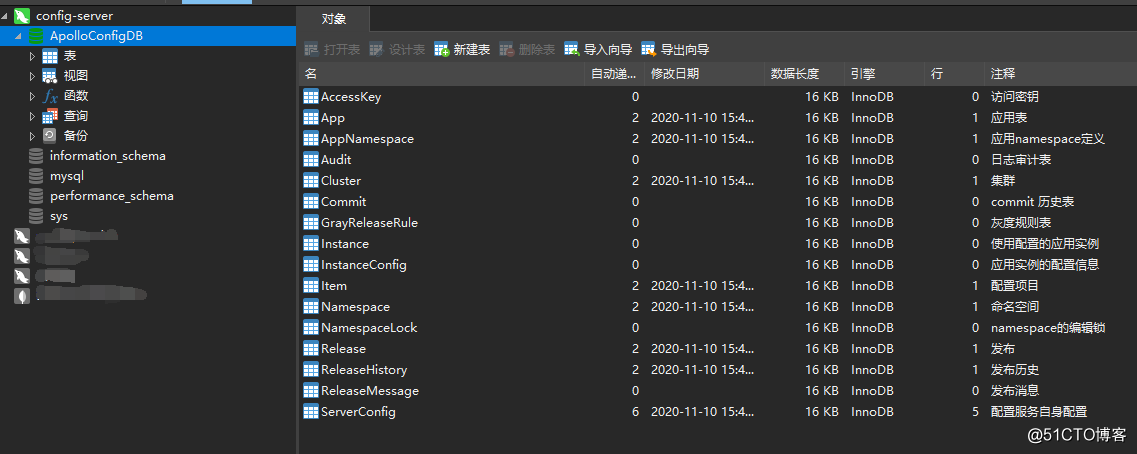
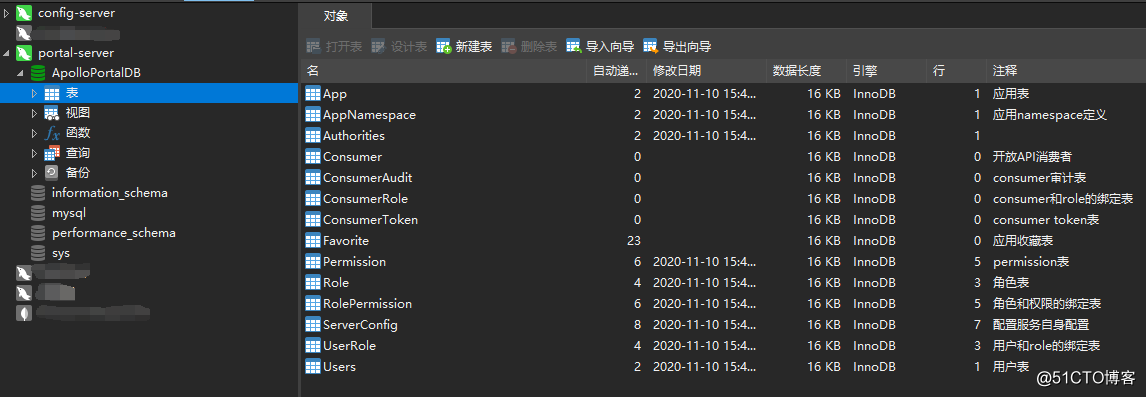
Get the installation package##
There are 3 installation packages required:
- apollo-configservice
- apollo-adminservice
- apollo-portal
You can download the official installation package directly, or you can build it from the source code. Since there is no need to modify the source code, I download the installation package directly here. See Github Releases for the download address.
Copy the download link and use the wget command to download on the server or upload it to the server after downloading locally. The installation package of config-server is as follows:
[ root@config-server ~]# cd /usr/local/src
[ root@config-server /usr/local/src]# ls
apollo-adminservice-1.7.1-github.zip apollo-configservice-1.7.1-github.zip
[ root@config-server /usr/local/src]#
The installation package of portal-server is as follows:
[ root@portal-server ~]# cd /usr/local/src
[ root@portal-server /usr/local/src]# ls
apollo-portal-1.7.1-github.zip
[ root@portal-server /usr/local/src]#
Deploy Apollo Config Server
Unzip the compressed package to a suitable directory:
[ root@config-server /usr/local/src]# mkdir /usr/local/apollo-configservice
[ root@config-server /usr/local/src]# unzip apollo-configservice-1.7.1-github.zip -d /usr/local/apollo-configservice
[ root@config-server /usr/local/src]# mkdir /usr/local/apollo-adminservice
[ root@config-server /usr/local/src]# unzip apollo-adminservice-1.7.1-github.zip -d /usr/local/apollo-adminservice/[root@config-server /usr/local/src]# ls /usr/local/apollo-configservice
apollo-configservice-1.7.1.jar apollo-configservice-1.7.1-sources.jar apollo-configservice.conf config scripts
[ root@config-server /usr/local/src]# ls /usr/local/apollo-adminservice/
apollo-adminservice-1.7.1.jar apollo-adminservice-1.7.1-sources.jar apollo-adminservice.conf config scripts
[ root@config-server /usr/local/src]#
Configure the database connection information of apollo-configservice:
[ root@config-server /usr/local/src]# cd /usr/local/apollo-configservice/[root@config-server /usr/local/apollo-configservice]# vim config/application-github.properties
# DataSource
spring.datasource.url = jdbc:mysql://localhost:3306/ApolloConfigDB?characterEncoding=utf8&serverTimezone=Asia/Shanghai&useSSL=false
spring.datasource.username = root
spring.datasource.password = 123456a.
- Fill in the correct
ApolloConfigDBdatabase connection string information, pay attention to the user name and password without spaces!
Configure the database connection information of apollo-adminservice:
[ root@config-server /usr/local/apollo-configservice]# cd ../apollo-adminservice/[root@config-server /usr/local/apollo-adminservice]# vim config/application-github.properties
# DataSource
spring.datasource.url = jdbc:mysql://localhost:3306/ApolloConfigDB?characterEncoding=utf8&serverTimezone=Asia/Shanghai&useSSL=false
spring.datasource.username = root
spring.datasource.password = 123456a.
- Fill in the correct
ApolloConfigDBdatabase connection string information, pay attention to the user name and password without spaces!
If you need to adjust the configuration of apollo-configservice and apollo-adminservice's JVM startup parameters, service monitoring port, and log file storage directory, you can modify it in the scripts/startup.sh under the installation directory:
- If you need to modify the JVM parameters, you can modify the
JAVA_OPTSpart ofscripts/startup.sh - To adjust the log output path of the service, you can modify the
LOG_DIRinscripts/startup.shandapollo-configservice.conf - To adjust the listening port of the service, you can modify the
SERVER_PORTinscripts/startup.sh. In addition, since apollo-configservice also assumes the responsibility of the meta server, if you want to modify the port, you must also modify theeureka.service.urlconfiguration item in theApolloConfigDB.ServerConfigtable and the ones used in apollo-portal and apollo-client meta server information
Start apollo-configservice:
[ root@config-server /usr/local/apollo-configservice]# scripts/startup.sh
2020 Tuesday, November 10,:34:22 CST ==== Starting ====
Started [20958]
Waiting for server startup...Tuesday, November 10, 2020 16:34:38 CST Server started in15 seconds![root@config-server /usr/local/apollo-configservice]#
Check whether the startup is successful:
[ root@config-server /usr/local/apollo-configservice]# jps
1655 apollo-configservice.jar
1807 Jps
[ root@config-server /usr/local/apollo-configservice]# netstat -lntp |grep 8080
tcp6 00:::8080:::* LISTEN 1655/java
[ root@config-server /usr/local/apollo-configservice]#
Start apollo-adminservice:
[ root@config-server /usr/local/apollo-adminservice]# scripts/startup.sh
2020 Tuesday, November 10,:39:46 CST ==== Starting ====
Started [1886]
Waiting for server startup...Tuesday, November 10, 2020 16:40:01 CST Server started in15 seconds![root@config-server /usr/local/apollo-adminservice]#
Check whether the startup is successful:
[ root@config-server /usr/local/apollo-adminservice]# jps
1655 apollo-configservice.jar
2012 Jps
1886 apollo-adminservice.jar
[ root@config-server /usr/local/apollo-adminservice]# netstat -lntp |grep 8090
tcp6 00:::8090:::* LISTEN 1886/java
[ root@config-server /usr/local/apollo-adminservice]#
If you want to stop the service, just execute the scripts/shutdown.sh in the corresponding service directory.
Deploy Apollo Portal Server
Similar to the previous section, unzip the compressed package to a suitable directory:
[ root@portal-server /usr/local/src]# mkdir /usr/local/apollo-portal
[ root@portal-server /usr/local/src]# unzip apollo-portal-1.7.1-github.zip -d /usr/local/apollo-portal/[root@portal-server /usr/local/src]# ls /usr/local/apollo-portal/
apollo-portal-1.7.1.jar apollo-portal-1.7.1-sources.jar apollo-portal.conf config scripts
[ root@portal-server /usr/local/src]#
Configure the database connection information for apollo-portal:
[ root@portal-server /usr/local/src]# cd /usr/local/apollo-portal/[root@portal-server /usr/local/apollo-portal]# vim config/application-github.properties
# DataSource
spring.datasource.url = jdbc:mysql://localhost:3306/ApolloPortalDB?characterEncoding=utf8&serverTimezone=Asia/Shanghai&useSSL=false
spring.datasource.username = root
spring.datasource.password = 123456a.
Then it is to configure the meta service information of apollo-portal. Apollo Portal needs to access different meta service (apollo-configservice) addresses in different environments, so we need to provide this information in the configuration.
By default, meta service and config service are deployed in the same JVM process, so the address of meta service is the address of config service. The format of the configuration item is env.meta=http://{config-service-url:port}, as shown below:
[ root@portal-server /usr/local/apollo-portal]# vim config/apollo-env.properties
dev.meta=http://192.168.243.159:8080
- If an environment is not needed, you can also directly delete the corresponding configuration items. I deleted the default other environments here, and only configured
dev.meta
In addition to configuring meta service through apollo-env.properties, apollo also supports specifying meta service at runtime (priority is higher than apollo-env.properties):
- Specified by Java System Property
${env}_meta
- Can be specified by Java System Property
${env}_meta - Such as
java -Ddev_meta=http://config-service-url -jar xxx.jar - It can also be specified by program, such as
System.setProperty("dev_meta", "http://config-service-url");
- Specified by the operating system's System Environment
${ENV}_META
- Such as
DEV_META=http://config-service-url - Note that the key is all uppercase and separated by "_"
Start apollo-portal:
[ root@portal-server /usr/local/apollo-portal]# scripts/startup.sh
2020 Tuesday, November 10,:56:36 CST ==== Starting ====
Started [21010]
Waiting for server startup........Tuesday, November 10, 2020 16:57:17 CST Server started in40 seconds![root@portal-server /usr/local/apollo-portal]#
Check whether the startup is successful:
[ root@portal-server /usr/local/apollo-portal]# jps
21010 apollo-portal.jar
21162 Jps
[ root@portal-server /usr/local/apollo-portal]# netstat -lntp |grep 8070
tcp6 00:::8070:::* LISTEN 21010/java
[ root@portal-server /usr/local/apollo-portal]#
After the startup is successful, access port 8070 of portal-server through a browser:
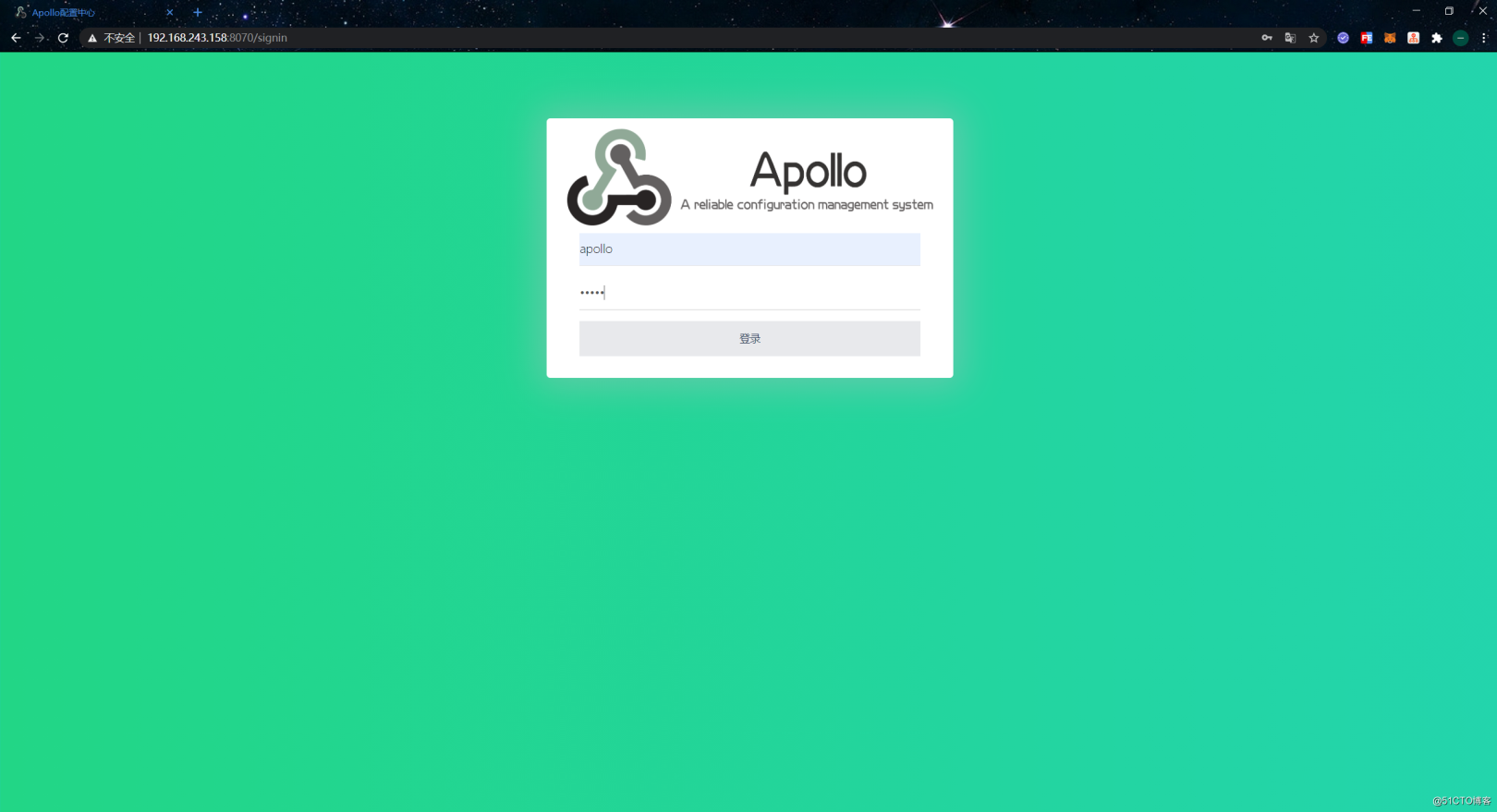
- The default username and password is: apollo/admin
After successful login, enter the home page:

Then you can enter the sample project to do some tests to see if it works normally:
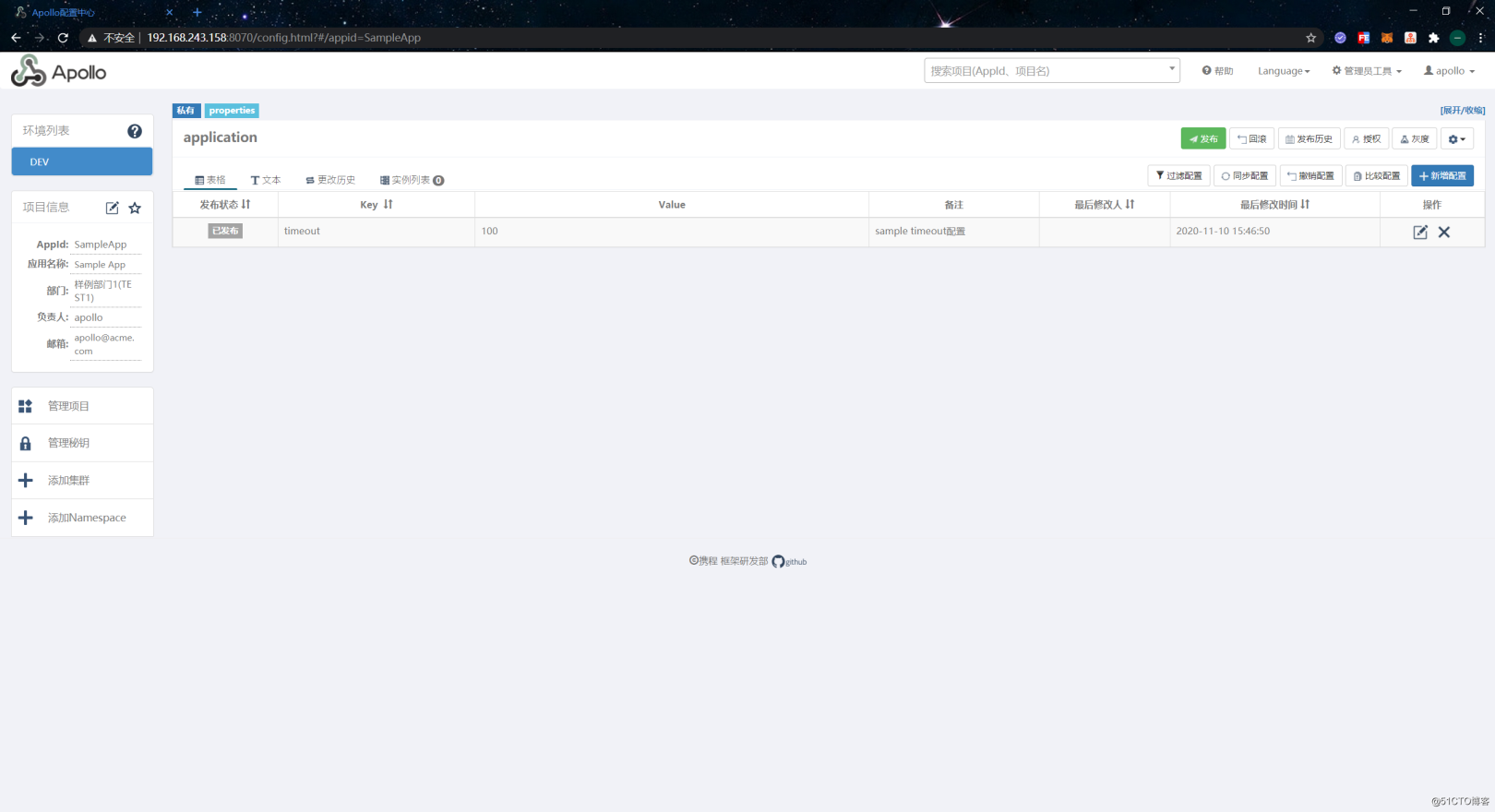
At this point we have completed the distributed deployment of Apollo. Here is just one set of environments. If there are multiple sets of environments, you only need to repeat the steps in the Apollo Config Server section to deploy multiple Config Server nodes. Then configure the access addresses of these Config Server nodes in the apollo-env.properties configuration file of Portal Server.
Recommended Posts